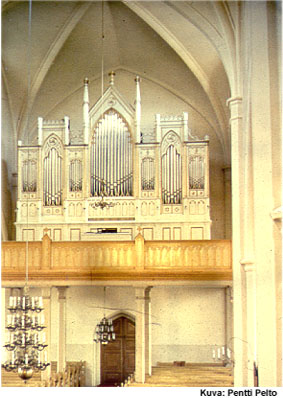|
HISTORICAL ORGANS IN FINLAND 
Uusikaupunki Church- Marcussen & Son 1865
- 28 stops, 2 manuals and pedal
- mechanical action and mechanical stop action
Uusikaupunki Church, a nave church with steeple, was built to a design by G.Th. Chiewitz in 1863. Its exterior is of unfaced brick, and its angular choir is narrower than the nave.
Soon after the church was completed, a local merchant named Gabriel Ceder expressed a desire to finance the commissioning of an organ. Because there was a considerable Danish community in the town at the time, it was only natural to commission the organ from Denmark. The venerable Marcussen organ builders were chosen, and it was determined that the new instrument was to be a ‘sister instrument’ to an organ built earlier; this rendered it somewhat cheaper.
In 1924, Kangasalan Urkutehdas replaced three stops in the organ. This, apart from the addition of a blower, is the only change made to the organ. The brothers Moberg of Sweden restored and repaired the instrument in 1978. Today, the organ is a fine example of the Danish organ building practice of its time. It also had added significance in that Jens Alexander Zachariassen, who came to Uusikaupunki to install the organ, chose to remain in Finland to pursue a career as an organ builder.
Appearance
The organ is situated in the western loft of a well-lit church. The conventional design at the time was to put the components in line, but here the arrangement is different: the halves of the Manual I chest are in the middle behind the façade. They are flanked by the halves of the Pedal chest, and the Manual II chest is behind them. The console is in the front in the middle, and the organist sits facing the church.
The façade is divided into seven parts. In the middle is a large pointed-arch flat flanked by medium-size flats which are in turn framed by smaller flats. The pipe groupings are symmetrical, and their mouths form quite a steep V figure. The middle flat is bound by high pillars, topped with finials. There are decorative niches between the profiled moulding encircling the upper edge of the lower part of the façade and the façade pipes. The façade is large, impressive and well-proportioned.
Technical features
The chests are slider chests. The halves of the Manual I chest are divided alternately, with the large pipes being placed on the centreline of the organ. The Pedal chest is divided in the same way. The Manual II chest, on the other hand, is chromatic. Whereas the Manual I and Pedal actions run through rollerboards as usual, the Manual II sliders are organized radially.
The frames of the manual keyboards have intarsia flower ornaments, and the builder’s large-size signature is mounted above the second manual keyboard. The stop knobs have printed porcelain ends. Apparently, the console originally only had normal couplings, since the switch for the Manual I octave coupling is at the right end of the keyboard like an afterthought. There is no II-Ped coupling. The console and action components are quite large and heavy, but manufactured with care and precision.
Musical properties
The touch of the instrument is exactly what one might expect from observing the structure. The action is reliable and precise, though not particularly sensitive. This poses certain limits to playing the instrument. Fast tempos are possible, but require strength and do not come naturally. This is an instrument built to last.
The disposition contains several typical Danish features, which in turn go back to German Romanticism. There are similar stops on both manuals, differing only in volume. The large Borduna on Manual I corresponds to the quieter and more lyrical Gedackt on Manual II, while a Principal is matched with a narrower Geigenprincipal. There are also parallel violin and flute stops. There is one overblowing stop included. The Cornett contains the fifth and third of a 16’ stop.
The organ has a noble, solemn and powerful sound.
Disposition
Manual I C-f3 | Manual II C-f3 | Pedal C-d1 |
Borduna 16’ | Gedackt 16’ | Principal 16’ |
Principal 8’ | Geig.principal 8’ | Subbas 16’ |
Fleute major 8’ | Rörfleute 8’ | Principal 8’ |
Fleute harmonique 8’ | Salicional 8’ | Violoncell 8’ |
Viola da Gamba 8’ | Gedackt 8’ | Gedackt 8’ |
Octava 4’ | Gambetti 4’ | Octava 4’ |
Gemshorn 4’ | Fleute 4’ | Bassun 16’ |
Qvinta 3’ | Clarinett 8’ | Bassun 8’ |
Octava 2’ | | |
Cornett 4chor c1-f3 | | |
Mixtur 1-3chor | | |
Trompete 8’ | | |
| | |
|
|
|
Couplings: II-I, I-Ped, I 4’, | | |
Manual-forte, Pedal-forte. | | |
Manual II in swell box. | | |
| | |
| | |
| | |
| | |
| | |
| | |
| | |
| | |
| | |
| | |
|